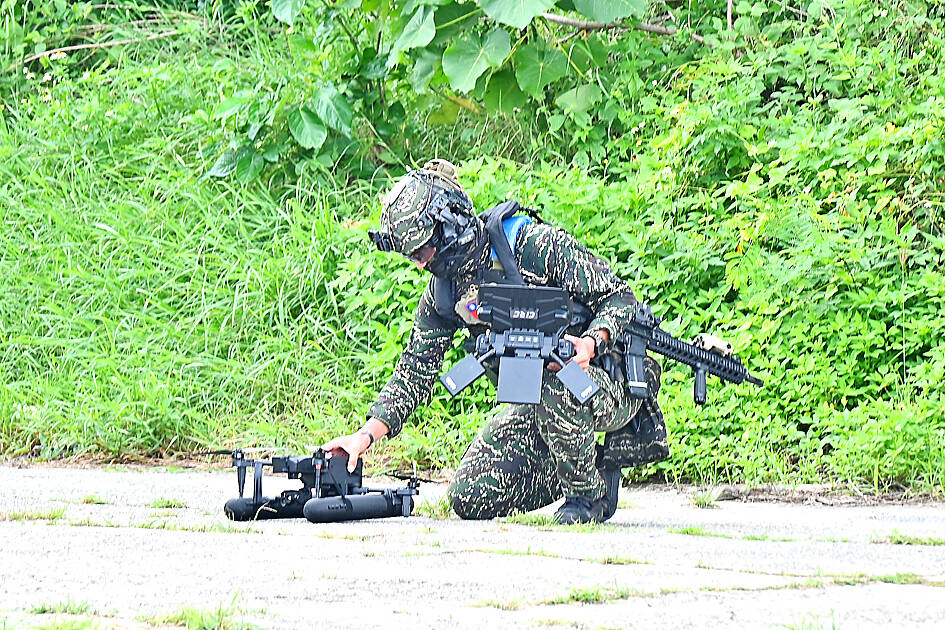The US Department of Defense needs to “swiftly develop counter drone capabilities,” as US forces are unprepared for threats from low-cost drones in the Middle East or in potential conflicts with China over Taiwan, a US think tank said on Wednesday.
US air dominance is being undermined by drones used as mass precision weapons, as seen in the Middle East, the Center for a New American Security (CNAS) said in a report.
CNAS defense program director Stacie Pettyjohn and research assistant Molly Campbell in the report analyzed US combat operations in the Middle East to assess whether the country is prepared for drone threats, especially from China.

Photo: Lee Hui-chou, Taipei Times
Since 2004, Iran-produced drones have provided Tehran-backed proxy forces with cheap precision weapons more accurate than missiles or rockets, imposing disproportionate costs on the US, the report said.
US troops have used missiles costing up to millions of dollars to take down drones worth US$50,000, which is not cost-effective or sustainable, CNAS said.
The report described China as Washington’s “foremost strategic threat,” and said that the Chinese People’s Liberation Army “is rapidly advancing its drone capabilities by developing more autonomous systems and acquiring them at scale.”
CNAS conducted a tabletop exercise to examine US capabilities against Chinese drone attacks if a protracted war over Taiwan took place, with US forces operating from a Japanese outlying island and the Philippines, the report said.
The exercise showed that Chinese drones pose a very different threat than those in the Middle East or Ukraine, it said.
Given the Indo-Pacific region’s vast distances and geography, sustained drone attacks could suppress US forces and overwhelm active defenses, such as jammers, missile interceptors and high-power microwaves, the report said.
CNAS recommended that the US build large stockpiles of proven counter drone systems and invest in mobile, easily repositioned defenses to protect forces across the region.
“Without deep magazines of substantially enhanced counter-drone capabilities, the United States risks having its distributed warfighting strategies overwhelmed by massed Chinese drone attacks, and could lose a war over Taiwan,” it said.

SHIPS, TRAINS AND AUTOMOBILES: The ministry has announced changes to varied transportation industries taking effect soon, with a number of effects for passengers Beginning next month, the post office is canceling signature upon delivery and written inquiry services for international registered small packets in accordance with the new policy of the Universal Postal Union, the Ministry of Transportation and Communications said yesterday. The new policy does not apply to packets that are to be delivered to China, the ministry said. Senders of international registered small packets would receive a NT$10 rebate on postage if the packets are sent from Jan. 1 to March 31, it added. The ministry said that three other policies are also scheduled to take effect next month. International cruise ship operators

NUMBERS IMBALANCE: More than 4 million Taiwanese have visited China this year, while only about half a million Chinese have visited here Beijing has yet to respond to Taiwan’s requests for negotiation over matters related to the recovery of cross-strait tourism, the Tourism Administration said yesterday. Taiwan’s tourism authority issued the statement after Chinese-language daily the China Times reported yesterday that the government’s policy of banning group tours to China does not stop Taiwanese from visiting the country. As of October, more than 4.2 million had traveled to China this year, exceeding last year. Beijing estimated the number of Taiwanese tourists in China could reach 4.5 million this year. By contrast, only 500,000 Chinese tourists are expected in Taiwan, the report said. The report

The Forestry and Nature Conservation Agency yesterday launched a gift box to market honey “certified by a Formosan black bear” in appreciation of a beekeeper’s amicable interaction with a honey-thieving bear. Beekeeper Chih Ming-chen (池明鎮) in January inspected his bee farm in Hualien County’s Jhuosi Township (卓溪) and found that more than 20 beehives had been destroyed and many hives were eaten, with bear droppings and paw prints near the destroyed hives, the agency said. Chih returned to the farm to move the remaining beehives away that evening when he encountered a Formosan black bear only 20m away, the agency said. The bear

HORROR STORIES: One victim recounted not realizing they had been stabbed and seeing people bleeding, while another recalled breaking down in tears after fleeing A man on Friday died after he tried to fight the knife-wielding suspect who went on a stabbing spree near two of Taipei’s busiest metro stations, Taipei Mayor Chiang Wan-an (蔣萬安) said. The 57-year-old man, identified by his family name, Yu (余), encountered the suspect at Exit M7 of Taipei Main Station and immediately tried to stop him, but was fatally wounded and later died, Chiang said, calling the incident “heartbreaking.” Yu’s family would receive at least NT$5 million (US$158,584) in compensation through the Taipei Rapid Transit Corp’s (TRTC) insurance coverage, he said after convening an emergency security response meeting yesterday morning. National